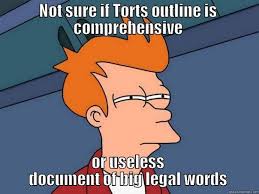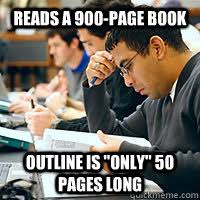Congratulations On Getting to Week Three!!!
You've read for classes, been cold called, gotten used to the building and professors, and now, it's time to OUTLINE.
You have finally finished a topic in one of your classes, battery to be specific. You're sitting there with your notes and textbook in front of you thinking, "what do I do with this stuff now?????"
The answer: the ever elusive outline!
You may ask: "But how do I outline? What is my outline supposed to look like?"
The answer: the most annoying, "whatever works for you!"
Your response: "BUT I DON'T KNOW WHAT WORKS FOR ME!"
The truth is, however, the best outline you can use to study is the one you make yourself. I know it's frustrating, but that's the one consistent answer you will get from anyone you ask. You have to make the outline work for you.
You'll also frequently hear:
1) The outline you make will constantly change as you learn more information from class;
2) The outline doesn't have to be pretty, it just has to work for you; and
3) It just takes time to figure out what works for you, keep trying.
While those are all true, I am going to give you some advice to get started.
The first thing you need to remember is that outlining is only part of what you need to do to study. It is incredibly important to outline and put all of the information you've learned into one document for easy access and to organize your thought process. But you also need to memorize the rules, practice writing essays, and practice answering multiple choice questions. When you do practice exams you learn where your understanding is deficient and where you need to focus your studying a little more.
The second bit of advice is to play around with different versions of your outline. When you do this, you have to keep in mind how you learn best. Are you and auditory learner, visual learner, kinesthetic learner, or a different type of learner.
The way you learn best will be your best guide to your outlining process.
All that being said, we still need to talk about the way your outline looks.

This is the tricky part and also where your learning style comes into play. Your outline could be a flow chart, a list with bullets/numbers, a page with pictures that remind you of the topic and rules your organizing, it really doesn't matter how the outline looks as long as it works. You could have two outlines for each class, one big picture outline that simply puts topics together and helps you see what goes together and how the rules you've learned work together.
There is no short and fast guide or easy rule for outlining. You truly have to figure out what works best for you. Play around with your outlines until you start to figure it out. Make sure you have your outlines updated before midterm week. Once you get your grades you can see if the outline you made worked for you or if you need to change it a little bit.
To summarize everything, outlining is important, but so are other formats of studying; your outline needs to work for you; there is no set form your outline needs to take; and this can be a frustrating process the first time you do it because it's new and you have nothing to base your work on.
Take a breath, gather your notes, and just put something on paper. Ask your professors questions if you have them. It is now time to start outlining!




